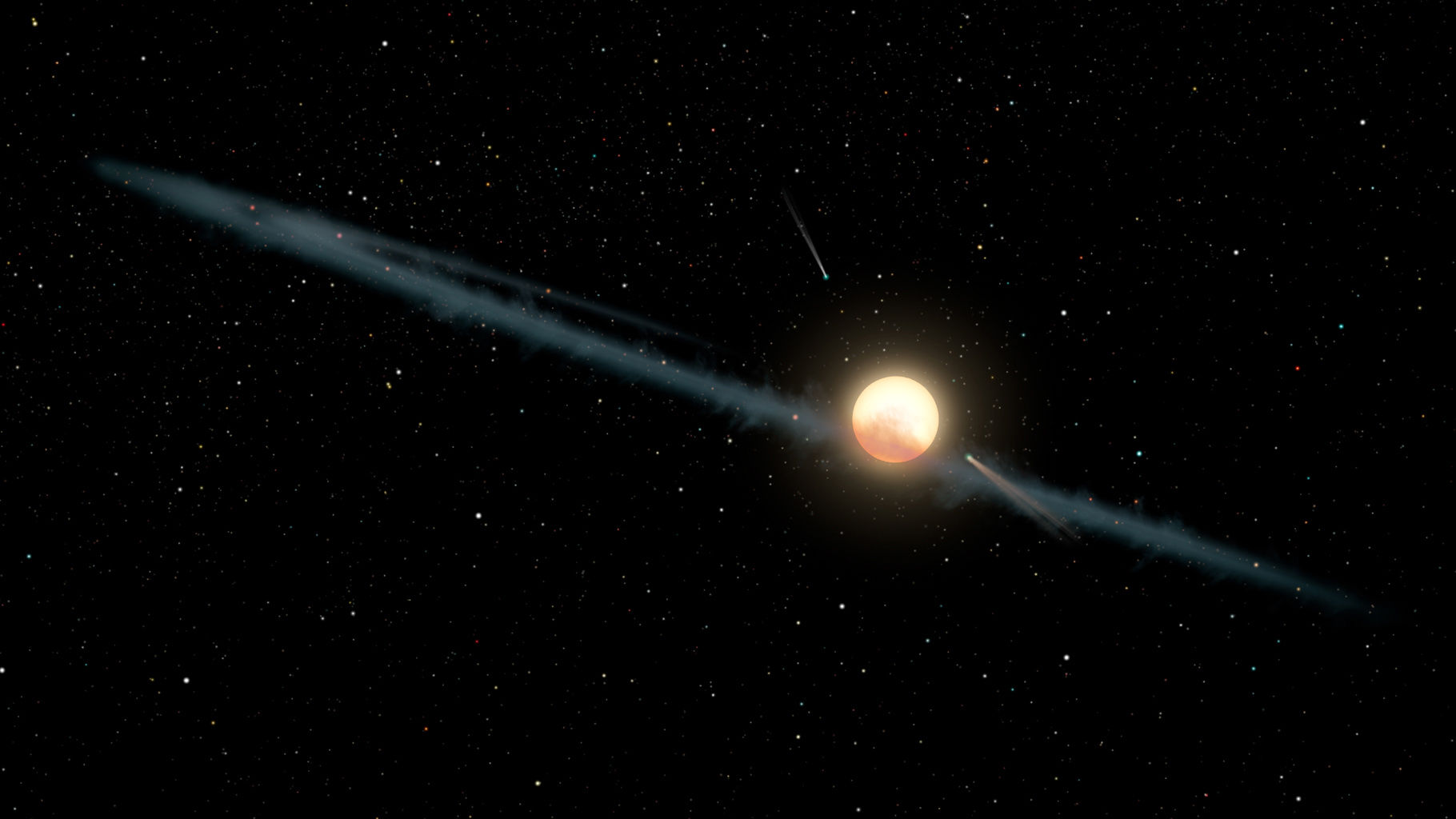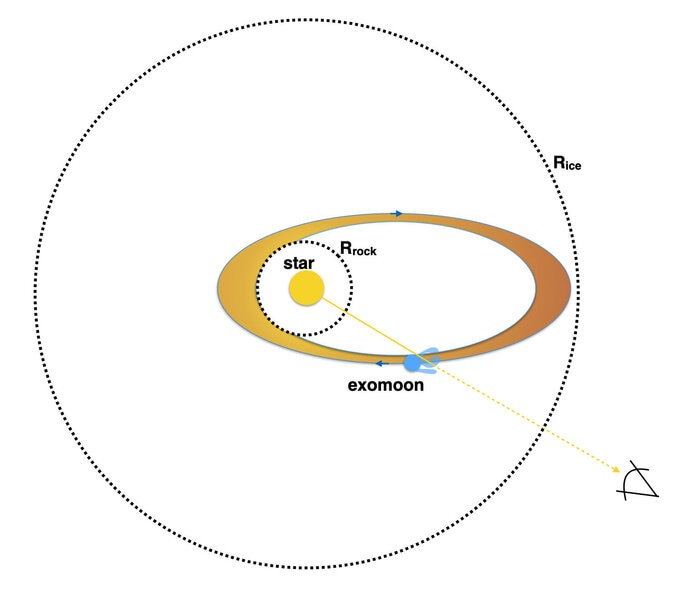Create a free profile to get unlimited access to exclusive videos, sweepstakes, and more!
Boyajian's Star: Could its bizarre behavior be due to an evaporating exomoon?

So literally on Monday I wrote an article about the star KIC 8462852 — aka Tabby's Star, or as I prefer it Boyajian's Star, the weird star that has been showing extremely bizarre behavior. It undergoes fairly random dips in the light we see from it, some of which are extremely deep. So deep, in fact, that it's difficult to explain them; one, for example, blocked 22% of the star's light! A planet can't do that, because a planet that big would be a star itself!
A lot of ideas have been proposed, including colliding planets, comets, asteroid collisions, a tilted disk of dust, and more. Even aliens, as you may recall, building a gigantic megastructure around the star to capture all its light to power their growing civilization.
Nothing really explains everything we see. New observations showed that the star's blue light gets blocked more than red, so we know dust is involved; that's exactly what dust does. But another study showed that the star itself is getting dimmer overall extremely slowly, like over a timescale of centuries! Also, whatever it is can't be too rare, because a whole slew of other stars has now been found that behave like Boyajian's Star. Nothing has been able to explain all these observations simultaneously.
Except maybe now something has. A new paper shows that the answer to Boyajian's Star's riddle may be… evaporating exomoons.
Whoa. OK, a little background info here. First, this video by Dr. Boyajian herself is a great primer on the star:
Orbital mechanics is funny. When you have lots of massive objects like planets orbiting a star, they can interact in weird and non-intuitive ways. Sure, if a big planet happens to pass by a smaller one, the smaller one can get tossed around, possibly ejected from the system or dropped into the star. But not all effects are so gross and hamfisted.
Take, for example, the Kozai-Lidov mechanism. Two planets orbiting relatively far apart still very subtly interact with each other gravitationally. Over time, like many individual orbits of both planets, they can exchange orbital angular momentum. What that means is that they affect the shapes of each others' orbits. This mechanism can change the tilt of the orbits, for example, or the eccentricity (how elliptical the orbit is). That last one is the key here, and what the new research focused on.
Imagine a star with two planets. One planet orbits it a few hundred million kilometers away (few times the distance of Earth from the Sun), the other farther out. Also, the inner planet has a moon, an icy one like the big moons of Jupiter and Saturn. Over decades the planets interact, and the inner planet's orbit slowly gets more and more elliptical. This means it drops down a wee bit closer and closer to the star every orbit.
At some point it will get close enough to the star that the star's gravity starts to tug on the moon. This is called a tidal interaction, and as the planet keeps getting closer the star can yank the moon away from the planet entirely!
This can be a good thing for the moon, because in many cases the research showed that its parent planet can get driven right down into the star. The planet is of course destroyed, ripped apart by the gravity of the star and eaten, while the moon outlives its planet.
But maybe not for long. The astronomers found that most of the time the moon eventually is also either dropped into the star — pfffffttttt — or is ejected from the system. But sometimes the moon winds up in a stable, if close, elliptical orbit around the star. The exomoon becomes an exoplanet in its own right.
But again, maybe not for so long. If the orbit is sufficiently close to the star the heat from the star will start to vaporize the stuff on the surface, and eventually deeper inside the moon. This will create a thick cloud of ice and dust around the star, and the exomoon/planet is now also like an exocomet. Over time, the starlight will blow that material away, but that takes a long time.
There are also larger particle ejected in this process. These stay more or less in the same elliptical orbit around the star as the moon, but slowly spread out over time, and may clump together to form larger particles.
And that's the scenario they propose for Boyajian's star. In this case we start with a planet that has a few icy moons. We don't know if there's a second planet orbiting farther out, but there may be a substitute: There is also a red dwarf star relatively close in the sky to the star, and may be a binary companion (this is still not clear; hopefully we'll know better in a while as more observations can pin that down). Over time, the above situation plays out: The planet drops into the star due to tugs by the red dwarf, the moon (or moons) get into its own individual elliptical orbit, starts to outgas, and eventually creates a ring of material that orbits the star on a similar path.
The gradual dimming of the star seen over centuries is due to the dust and gas blown out as the moon evaporates. The cloud grows, dimming the star. Larger particles block light across the spectrum. So we see what's called "secular dimming," that is, all colors dim equally.
But the dips seen first by the Kepler observatory and then eventually many ground-based telescopes are due to particles surrounding the moon itself, some of which can be decently sized. They don't have any particular pattern to them, so some block a little light, some block lots. They represent a thickening in the "tail" of the exomoon, which is dusty, and blocks blue light more than red. Also, the really big dips would be caused by the moon itself (or what remains of it as it evaporates… or even multiple moons evaporating). It's surrounded by a thick clump of dust as well, which can be hundreds of thousands of kilometers across. It may physically block much of the star from us, but it's translucent, so it can't block all the light. Also, the tilt of the orbit of the moon as it evaporates may be why we don't see these dips all the time; we only see them when the moon is near the star from our viewing geometry, and its dragging all this junk along with it.
I have to say, as explanations go, this one is very compelling. It explains all the weird behavior, invokes physics we understand, will happen rarely (you need a specific setup of planets and moons and/or companions to do this) but is not so off-the-wall that you'd never expect it to happen.
And I have to admit being personally drawn to an explanation that's so casually cataclysmic. Planets being tossed around! Then destroyed! Orphaned moons, slowly evaporating, eventually to be destroyed by the star as well! And the whole process takes under a million years, sometimes only a few tens of thousands of years, making it rare but not impossible. Amazing. [Note: Another paper was also recently published with a pretty similar scenario.]
However, liking it as well as having it be consistent internally and with observations doesn't make it right. It's one hypothesis out of many, but it's a good one, and worth investigating more carefully and thoroughly. And now that we know of a couple of dozen more "big dippers," we have plenty of targets to look into.




























